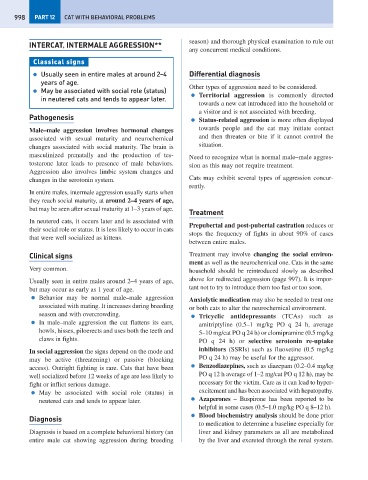Page 1006 - Problem-Based Feline Medicine
P. 1006
998 PART 12 CAT WITH BEHAVIORAL PROBLEMS
season) and thorough physical examination to rule out
INTERCAT, INTERMALE AGGRESSION**
any concurrent medical conditions.
Classical signs
● Usually seen in entire males at around 2–4 Differential diagnosis
years of age.
Other types of aggression need to be considered.
● May be associated with social role (status)
● Territorial aggression is commonly directed
in neutered cats and tends to appear later.
towards a new cat introduced into the household or
a visitor and is not associated with breeding.
Pathogenesis ● Status-related aggression is more often displayed
Male–male aggression involves hormonal changes towards people and the cat may initiate contact
associated with sexual maturity and neurochemical and then threaten or bite if it cannot control the
changes associated with social maturity. The brain is situation.
masculinized prenatally and the production of tes- Need to recognize what is normal male–male aggres-
tosterone later leads to presence of male behaviors. sion as this may not require treatment.
Aggression also involves limbic system changes and
changes in the serotonin system. Cats may exhibit several types of aggression concur-
rently.
In entire males, intermale aggression usually starts when
they reach social maturity, at around 2–4 years of age,
but may be seen after sexual maturity at 1–3 years of age.
Treatment
In neutered cats, it occurs later and is associated with
Prepubertal and post-pubertal castration reduces or
their social role or status. It is less likely to occur in cats
stops the frequency of fights in about 90% of cases
that were well socialized as kittens.
between entire males.
Clinical signs Treatment may involve changing the social environ-
ment as well as the neurochemical one. Cats in the same
Very common. household should be reintroduced slowly as described
Usually seen in entire males around 2–4 years of age, above for redirected aggression (page 997). It is impor-
but may occur as early as 1 year of age. tant not to try to introduce them too fast or too soon.
● Behavior may be normal male–male aggression Anxiolytic medication may also be needed to treat one
associated with mating. It increases during breeding or both cats to alter the neurochemical environment.
season and with overcrowding. ● Tricyclic antidepressants (TCAs) such as
● In male–male aggression the cat flattens its ears, amitriptyline (0.5–1 mg/kg PO q 24 h, average
howls, hisses, piloerects and uses both the teeth and 5–10 mg/cat PO q 24 h) or clomipramine (0.5 mg/kg
claws in fights. PO q 24 h) or selective serotonin re-uptake
In social aggression the signs depend on the mode and inhibitors (SSRIs) such as fluoxetine (0.5 mg/kg
may be active (threatening) or passive (blocking PO q 24 h) may be useful for the aggressor.
access). Outright fighting is rare. Cats that have been ● Benzodiazepines, such as diazepam (0.2–0.4 mg/kg
well socialized before 12 weeks of age are less likely to PO q 12 h average of 1–2 mg/cat PO q 12 h), may be
fight or inflict serious damage. necessary for the victim. Care as it can lead to hyper-
● May be associated with social role (status) in excitement and has been associated with hepatopathy.
neutered cats and tends to appear later. ● Azaperones – Buspirone has been reported to be
helpful in some cases (0.5–1.0 mg/kg PO q 8–12 h).
● Blood biochemistry analysis should be done prior
Diagnosis
to medication to determine a baseline especially for
Diagnosis is based on a complete behavioral history (an liver and kidney parameters as all are metabolized
entire male cat showing aggression during breeding by the liver and excreted through the renal system.

